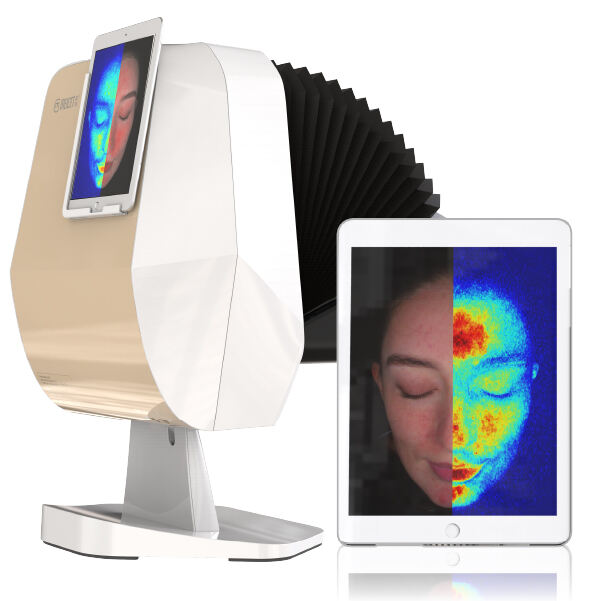
Thread lifts zijn uitgegroeid tot een veelzijdig instrument voor het aanpakken van lichte tot matige huidlaxiteit, met behulp van biologisch afbreekbare draden om hangende weefsels op te tillen en collageenproductie te stimuleren. Het succes hangt af van een nauwkeurige plaatsing die gebruik maakt van de unieke anatomie van de patiënt — botstructuur, vetverdeling en huiddikte — om de lift te maximaliseren en spanning te minimaliseren. Traditioneel plannen houdt vaak geen rekening met deze nuances, wat kan leiden tot suboptimale resultaten of complicaties zoals zichtbare draden. De MEICET MC88 Full Facial Skin Analyzer verandert het plannen van thread lifts door gebruik te maken van multispectrale weefselkaartvorming om de faciale structuur te beoordelen, zodat draden zo worden gepositioneerd dat ze in harmonie werken (en niet tegen) de natuurlijke structuur van het lichaam.
Kaartvorming van Laxiteit en Steunstructuren
Effectieve threadlifts richten zich op gebieden waar de huid zijn elasticiteit is verloren maar nog voldoende ondersteuning heeft (vetkussentjes, spieren of bot) om de threads te verankeren. Het geavanceerde beeldvormingssysteem van de MC88 identificeert deze belangrijke structuren:
- Analyse van de huiddikte met behulp van gepolariseerd licht (PPL) bepaalt het type draad en de benodigde diepte. Dikke huid (bijvoorbeeld kaaklijn) toont een hogere verstrooiing van licht in PPL-modus, wat aangeeft dat hier langere, gegroefde draden dieper in de onderhuidse laag kunnen worden geplaatst, terwijl dunne huid (bijvoorbeeld wangen) met lagere verstrooiing kortere, lichtere draden vereist om zichtbaarheid of extrusie te voorkomen.
- Mapping van de bot-weefselinterface via high-resolution zijwaartse beeldvorming licht gebieden uit waar draden kunnen profiteren van botuitsteeksels voor verankering. Het jukbeen of de kaaklijn verschijnt als een dicht, donker gebied in scans, wat een stabiele ondersteuning biedt waardoor draden met minimale spanning kunnen tillen—het risico op verplaatsing wordt hierdoor verminderd.
Een patiënt met een hangende onderste gezichtspartij kan MC88-scans hebben waaruit blijkt dat de laxiteit geconcentreerd is in de wangen (via toegenomen onregelmatigheid van de huidstructuur) met resterend vet in het submentale gebied (via hogere dichtheid). Dit leidt de plaatsing van draden langs de kaakbeenderen, waarbij gebruik wordt gemaakt van de bot-weefselinterface om de wangen op te tillen zonder te veel spanning op de dunne huid van de nek.
Bepaling van draadrichting en -dichtheid
De uitkomst van een draadlift hangt niet alleen af van waar de draden worden geplaatst, maar ook van hun oriëntatie. Dankzij de multi-hoek-beeldvorming van de MC88 kunnen artsen de optimale draadrichtingen en -dichtheden analyseren:
- Richtingsplanning optimaliseert de liftvector met behulp van huidspanningslijnanalyse. Voor een mid-face lift tonen MC88's multi-view scans aan dat draden die onder een hoek van 45 graden (in plaats van verticaal) worden geplaatst, in lijn liggen met de natuurlijke huidspanningslijnen, waardoor de spanning gelijkmatig wordt verdeeld en een meer natuurlijke, jeugdige contour ontstaat. Dit voorkomt de getrokken uitstraling van verticale draden die tegen de natuurlijke weefselbeweging inwerken.
- Dichtheidskaart zorgt voor voldoende ondersteuning zonder overbevolking door huidelasticiteit te kwantificeren. Patiënten met ernstige laxiteit (lage elasticiteit, gedetecteerd via textuuranalyse) hebben mogelijk meerdere draden in een 'net' patroon nodig, terwijl personen met lichte ptosis (hogere elasticiteit) slechts strategische plaatsing vereisen. MC88's elasticiteitsmetingen voorkomen overtreatment, wat dimpels of asymmetrie kan veroorzaken.
- Symmetrie-aanpassingen corrigeer natuurlijke gezichtsoneffenheden met behulp van vergelijkende frontale beeldvorming. Een patiënt met een iets lager linkerschild toont asymmetrische dichtheid in MC88-scans, wat de plaatsing van de draadjes leidt met iets meer spanning aan de linkerkant om het gezicht te balanceren zonder een onnatuurlijk uiterlijk te creëren.
Voor een patiënt die een wenkbrauwlifting wenst, kunnen MC88's zijkant- en frontscans aantonen dat draadjes die aan de zijkant (bij de slapen) worden geplaatst met een lichte opwaartse hoek beter aansluiten bij de spanningslijnen van het voorhoofd, waardoor een meer natuurlijke elevatie ontstaat dan draadjes die centraal worden geplaatst - het vermijden van het "verraste" uiterlijk van te strakke wenkbrauwen.
Voorspellen van collageenstimulatie en langetermijnresultaten
Draadjes tillen niet alleen op—ze stimuleren ook collageenvorming terwijl het lichaam geneest rondom hen. De longitudinale beeldvorming van de MC88 helpt bij het voorspellen hoe dit collageen zich zal integreren met het bestaand weefsel:
- Veranderingen in huidverdikking over tijd, gemonitord via PPL-afbeelding, geven aanwijzingen over collageenproductie. Verhoogde lichtverstrooiing in behandelde gebieden (een teken van dikker, meer gestructureerd weefsel) duidt aan dat de draden de gewenste genezingsreactie opwekken, waardoor het noodzakelijke aantal lifts wordt verminderd.
- Beoordelingen van contourstabiliteit na 3, 6 en 12 maanden maken gebruik van multispectrale textuuranalyse om aan te tonen hoeveel van de lift wordt onderhouden door collageen versus het mechanische effect van de draad. Eerste scans richten zich op de integriteit van de draad, terwijl latere scans de verbetering van de textuur meten – dit leidt tot onderhoudsplannen, ofwel een aanvulling met extra draden of een overgang naar collageenstimulerende topische producten.
Een patiënt met draadlifts in de kaaklijn kan MC88-scans hebben na 6 maanden met een toename van PPL-verstrooiing (wat collageengroei aangeeft) en stabiele textuur – hiermee wordt bevestigd dat de resultaten behouden blijven, ook naarmate de draden biologisch afbreken.
De MC88 Full Facial Skin Analyzer verheft de planning van thread lifts van empirisch naar wetenschappelijk, waardoor de threads in harmonie werken met de natuurlijke anatomie van het lichaam om een opgeheven, jeugdige uitkomst te realiseren. Door de ondersteunende structuren in kaart te brengen, de plaatsing te optimaliseren en de langetermijnresultaten te voorspellen, verandert het thread lifts in precieze, op maat gemaakte procedures die de faciale harmonie versterken in plaats van verstoren.
 EN
EN
 AR
AR
 BG
BG
 HR
HR
 CS
CS
 DA
DA
 NL
NL
 FI
FI
 FR
FR
 DE
DE
 EL
EL
 HI
HI
 IT
IT
 JA
JA
 KO
KO
 NO
NO
 PL
PL
 PT
PT
 RO
RO
 RU
RU
 ES
ES
 SV
SV
 TL
TL
 IW
IW
 ID
ID
 SR
SR
 SK
SK
 SL
SL
 UK
UK
 VI
VI
 SQ
SQ
 HU
HU
 TH
TH
 TR
TR
 FA
FA
 AF
AF
 MS
MS
 UR
UR
 BN
BN
 LA
LA

